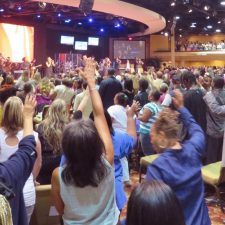 (Darrell B. Harrison – Kaleoscope) “The concept of the black race and the white race originated with the Enemy himself. Just as he sowed seeds of doubt in the garden of Eden with his “hath God really said,” he has continued through the ages to offer a lie in the place of God’s truth. His attack has been anything but subtle. This web of deceit has brought hatred and bigotry into the church. What we are left with is a huge divide that is no more evident than at the 11:00 worship hour on Sunday mornings.” – Dr. John M. Perkins, One Blood: Parting Words to the Church on Race
(Darrell B. Harrison – Kaleoscope) “The concept of the black race and the white race originated with the Enemy himself. Just as he sowed seeds of doubt in the garden of Eden with his “hath God really said,” he has continued through the ages to offer a lie in the place of God’s truth. His attack has been anything but subtle. This web of deceit has brought hatred and bigotry into the church. What we are left with is a huge divide that is no more evident than at the 11:00 worship hour on Sunday mornings.” – Dr. John M. Perkins, One Blood: Parting Words to the Church on Race
It was more than half a century ago, on December 18, 1963, to be exact, when, during a Q&A session at Western Michigan University, the Rev. Dr. Martin Luther King, Jr. stated the following: “We must face the fact that in America, the church is still the most segregated major institution in America. At 11:00 on Sunday morning, when we stand and sing and Christ has no east or west, we stand at the most segregated hour in this nation.”
“Segregated”?
Really?
Now, I want to say at the outset of this commentary that I do not ask that question in an effort to be facetious or to portray an acrimonious or argumentative attitude toward either Dr. King or his legacy as a civil rights leader.
Not at all.
Nevertheless, the truth is King’s assertion that 11:00 on Sunday mornings is the most “segregated” hour [in the American evangelical church] has essentially gone unchallenged since the day he uttered those words some 55 years ago – words that for many Christians who today identify as advocates and proponents of “social justice” within the evangelical church – serve as a primary impetus to promote a missiology founded upon the presupposition that the same culture of ethnic divisiveness to which Dr. King is alluding, a culture that initially gave rise to the Black Church in America, exists virtually unchanged today.
I, for one, do not believe that to be the case.
But what makes the ongoing appropriation of King’s declaration particularly concerning to me, is the dogmatic manner in which the term ‘segregated’ is used to describe what many believe to be an ethnic imbalance within American evangelical churches (and by “American evangelical churches” I’m referring specifically to churches whose congregations are predominantly white, as churches whose congregations are predominantly black, though perhaps just as ethnically imbalanced, if not more so, are never described in such terms.)
Never.
But, I digress.
When we hear words like segregated and segregation, more often than not we assume they are used within a contextual framework that is jaundiced and tendentious. This is particularly true given today’s socio-political milieu in which reminders of America’s history of ethnic discrimination against blacks and other ethnic minorities, especially in the case of Southern Baptist churches, seems incessant and ubiquitous.
That said, in no way am I discounting or minimizing that history. In fact, I am quite familiar with it on a somewhat personal level.
From 2009 to 2014, I was a member of a predominantly ethnically white Southern Baptist church whose origins date back to 1823, the same year that abolitionists Mary Ann Shad Cary and Mifflin Wistar Gibbs were born. But it wasn’t until the year 1827 that the church voted to allow blacks to become members.